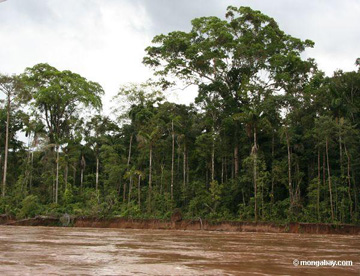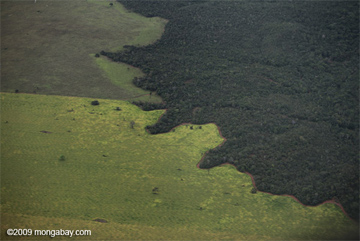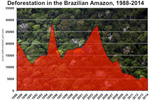A new study in Science is likely to reopen the contentious debate about the impact of climate change on tropical rainforests. Scientific modeling of future climate conditions in tropical rainforests, such as the Amazon, has shown that climate change—combined with deforestation and fire—could create a tipping point whereby a significant portion of the Amazon could turnover to savannah, pushing untold species to extinction and undercutting the many ecosystem services provided by tropical rainforests. Yet, a new study headed by Carlos Jaramillo, staff scientist at the Smithsonian Tropical Research Institute (STRI), has found a tropical forest ecosystem thriving in much warmer conditions than today.
While the study is notable, a conservation biologist at James Cook University who has spent decades working in the tropics, Dr. William Laurance, told mongabay.com that he “urge[s] people to be very cautious in extrapolating the lessons [of the study] to today.”
 The Tambopata River flows by the Amazon rainforest in Peru. Photo by: Rhett A. Butler. |
According to the study’s findings, some 56 million years ago, rainforests thrived in temperatures 3-5 degrees higher than today. Conservative estimates expect the tropics to see a 3-degree-rise by the end of the century. In addition, atmospheric carbon dioxide levels at the time were 2.5 times higher than today’s levels.
Examining prehistoric pollen in the Amazon from the global warming event dubbed the Paleocene-Eocene Thermal Maximum, researchers found that biodiversity exploded during this time with new species forming at a faster than species went extinct. Both passionflower plants and chocolate first evolved during this time.
But what does this really mean for the likely impacts of current global climate change on the world’s tropical rainforests?
“It is remarkable that there is so much concern about the effects of greenhouse conditions on tropical forests,” says Klaus Winter, staff scientist at STRI, in a press release.
Yet Winter adds that, “however, these horror scenarios probably have some validity if increased temperatures lead to more frequent or more severe drought as some of the current predictions for similar scenarios suggest.”
Laurance goes further, explaining that there are considerable differences between current climate change impacts and those highlighted in the study.
“The doubling of carbon dioxide at the Paleocene-Eocene boundary occurred over a period of some 10,000 years. Our current doubling of carbon dioxide is occurring far faster, with most of the increase happening in just a century or so—a rate a hundred times faster. This gives species far less time to migrate or adapt to changing conditions,” he says.
Like Winter, Laurance says that the key to rainforest survival in the future may not be temperature, but rather shifts in precipitation. This year, the Amazon experienced its worst drought in decades, pushing the Amazon River to its lowest point in a century.
“Rainfall regimes could change with global warming, and quite possibly in unpredictable ways. You can’t have a healthy rainforest without fairly consistent rainfall. In general atmospheric humidity will likely rise, but beyond this our capacity to predict local- and regional-scale changes is often appalling poor.”
 Deforestation in the Brazilian Amazon. Scientists say a combination of climate change, deforestation, fragmentation, and fire could flip a significant portion of the world’s largest rainforest to savannah. Photo by: Rhett A. Butler. |
In addition, while the study looks at species in lowland rainforests, Laurance points out that it neglects “higher-elevation specialists in the tropics.”
“It is these species which are adapted for living in wet, cloudy, cool conditions, that are probably most vulnerable to global warming,” he explains. “As the world heats up, these species literally have nowhere to go—aside from heaven, which is where a lot of them could end up.”
Finally, Laurance points out another significant difference between climate change 56 million years ago and climate change today: humans. Tropical forests are not only facing warmer temperatures, higher carbon levels, and perhaps drier conditions, but also have been undergoing vast environmental changes by people—including unprecedented deforestation.
“Species today are often besieged by an array of environmental insults—habitat loss and fragmentation, overhunting, invading species, and manifold other environmental changes—and these could greatly exacerbate the pressures resulting from climate change,” Laurance explains. “If this were a boxing match, nature isn’t just being jabbed once, but is suffering a flurry of blows arriving all at once.”
The theory that a significant portion of the Amazon is susceptible to flip over to savannah under climate change was a part of a recent journalistic scandal. Jonathan Leake, Science and Environment Editor of the Sunday Times, claimed that the theory was put forth by “green campaigners” with conservation group WWF and not scientists, since this was how it was cited in an IPCC report. However the Sunday Times was forced to retract the column when they realized the theory had robust scientific studies behind it and that Leake had misrepresented the opinions of scientists he spoke with and never contacted WWF.
CITATION: Jaramillo, C., Ochoa, D., Contreras, L., Pagani, M., Carvajal-Ortiz, H., Pratt, L., Krishnan, S., Cardona, A., Romero, M., Quiroz, L., Rodriguez, G., Rueda, M., de la Parra, F., Moron, S., Green, W., Bayona, G., Montes, C., Quintero, O., Ramirez, R., Mora, G., Schouten, S., Bermudez, Navarrete, R., Parra, F., Alvarán, M., Osorno, J., Crowley, J., Valencia, V., Vervoort, J. 2010. Effects of Rapid Global Warming at the Paleocene-Eocene Boundary on Neotropical Vegetation. Science.
Related articles
Amazon suffers worst drought in decades
(10/24/2010) The worst drought since 1963 has created a regional disaster in the Brazilian Amazon. Severely low water levels have isolated communities dependent on river transport. Given a worsening situation, Brazil announced on Friday an emergency package of $13.5 million for water purification, tents, and food airdrops.
Satellites show fragmented rainforests significantly drier than intact forest

(10/13/2010) A new study in Biological Conservation has shown that edge forests and forest patches are more vulnerable to burning because they are drier than intact forests. Using eight years of satellite imagery over East Amazonia, the researchers found that desiccation (extreme dryness) penetrated anywhere from 1 to 3 kilometers into forests depending on the level of fragmentation.
An undamaged Amazon produces its own clouds and rain
(09/21/2010) Researchers recently traveled to the remote Brazilian Amazon to investigate how clouds are formed and rain falls in an atmosphere unburdened by human-caused pollution. Studying the atmospheric aerosol particles, which impact cloud formation and particles, above a pristine forests, researchers discovered that when left alone the Amazon acts as its own ‘bioreactor’: clouds and precipitation are produced by the abundance of plant materials.
(06/21/2010) The Sunday Times over the weekend retracted a column that accused the Intergovernmental Panel on Climate Change (IPCC) of making a “bogus rainforest claim” when it cited a report warning that up to 40 percent of the Amazon could be “drastically” affected by climate change. The “Amazongate” column, authored by Jonathan Leake, Science & Environment Editor of the Sunday Times, was immediately seized upon by climate skeptics as further evidence to discredit the IPCC just two weeks after it was found to be using shoddy glacier data in its 2007 climate assessment. But now the Sunday Times has removed Leake’s column from its web site and issued on apology, admitting that the Amazon claim was indeed supported by scientific research. The Sunday Times also acknowledged misconduct in the way one of the story’s sources—Simon Lewis of the University of Leeds in Britain—was quoted.
]
Scientists: new study does not disprove climate change threat to Amazon

(03/19/2010) Recently, Boston University issued a press release on a scientific study regarding the Amazon’s resilience to drought. The press release claimed that the study had debunked the Intergovernmental Panel on Climate Change’s (IPCC) theory that climate change could turn approximately 40 percent of the Amazon into savanna due to declining rainfall. The story was picked up both by mass media, environmental news sites (including mongabay.com), and climate deniers’ blogs. However, nineteen of the world’s top Amazonian experts have issued a written response stating that the press release from Boston University was “misleading and inaccurate”.
Amazon confusion: new research shows forest is resilient to drought, but is this the whole picture?

(03/15/2010) A drought that happens once in a hundred years had little negative or positive effect on the Amazon rainforest according to a NASA funded study in Geophysical Research Letters. “We found no big differences in the greenness level of these forests between drought and non-drought years, which suggests that these forests may be more tolerant of droughts than we previously thought,” said Arindam Samanta, the study’s lead author from Boston University.